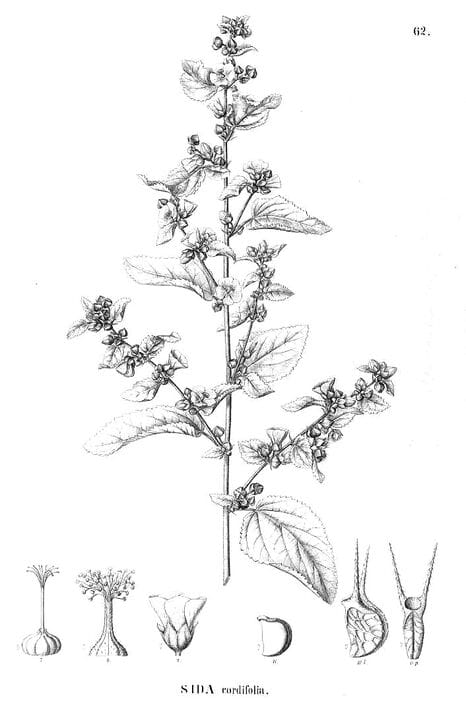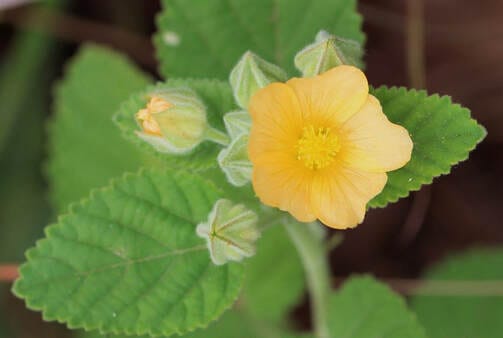Sida, Bala
Indian Country MallowBala (Ayurveda)
Bala, Beej Band (Unani)
Xin Yin Huang Hua Zai (TCM)
 Sida cordifolia
Sida cordifoliaMartius, Eichler, Urban, Flora Brasiliensis, 1891
 Sida cordifolia
Sida cordifolia(Photo by Karen Pagel) (Wikimedia)
 Members CLICK HERE for the PRO VERSION
Members CLICK HERE for the PRO VERSIONBotanical name:
Sida cordifolia (syn. Malva tormentosa)
Parts used:
Root (rarely the seed or fresh plant juice)
Temperature & Taste:
Cool, moist. Sweet
Uses:
1. Strengthens the Kidneys, Nourishes Yin:
-gives strength, weight-increasing, nourishing; weakness, fatigue, emaciation, convalescence
-increases sexual potency, nourishes Sperm, regarded as Aphrodisiac (root, seed)
–spermatorrhoea, nocturnal pollution, premature ejaculation, and to increase the viscosity of semen (seed, Unani)
-polyuria, urinary frequency
2. Clears Heat and Damp, Resists Poison:
-Urinary infection, blood in the urine
-Diarrhea, Dysentery
-Damp-Heat Jaundice (TCM)
3. Clears Heat, Resists Poison:
-Intermittent Fever with cold chills and shivering, followed by stronger heat and Fever
-heat-type Cough; Asthma
-Gonorrhea; Sexually Transmitted Disease
4. Nourishes Yin, Settles Wind:
-Neuralgia, Sciatica, Paralysis, Facial Paralysis
-Arrhythmia, Tachycardia, Irregular Pulse, Palpitations
-also for Mental Illness
5. Clears Heat, Stops Bleeding:
-Bleeding (decoct with milk)
-Excessive Menstrual Bleeding (powder with Honey)
6. Externally:
-external preparations (mostly oils) for arthritis, paralysis, hemiplegia, rheumatism and Vata/Wind diseases.
Dose:
Powder: 500mg–3 grams (5 grams daily);
Comment:
… available in PRO version
Substitutes:
… available in PRO version
Main Combinations:
Frequently combined with Abutilon Atibala in classical Ayurvedic texts.
1. Rejuvenate and regulates Wind constitutions:
i. Sida cordifolia, … available in PRO version
ii. Sida cordifolia with … available in PRO version
iii. Sida cordifolia, … available in PRO version
2. Urinary frequency or urgency from Heat:
i. Sida cordifolia powder … available in PRO version
ii. Sida cordifolia with … available in PRO version
3. Diarrhea, Sida … available in PRO version
4. Fever:
i. Intermittent Fever, Sida cordifolia … available in PRO version
ii. Sida cordifolia with … available in PRO version
iii. Chronic Fever, Edema, Anemia, Sida cordifolia with … available in PRO version
5. Asthma, Wheezing:
i. Sida cordifolia with … available in PRO version
ii. Sida cordifolia with … available in PRO version
6. Bronchitis with Fever, Sida cordifolia with … available in PRO version
7. Impotence, Sida cordifolia with … available in PRO version
8. Infertility:
i. Sida cordifolia with … available in PRO version
ii. Sida cordifolia with … available in PRO version
9. Paralysis, Facial Paralysis, Parkinsonism:
i. Sida cordifolia with … available in PRO version
ii. to the preceding can be added … available in PRO version
iii. Facial Paralysis and Sciatica, Sida cordifolia … available in PRO version
iv. Parkinson’s, Sida cordifolia, … available in PRO version
10. Heart disease:
i. Sida cordifolia with … available in PRO version
i. Sida cordifolia with … available in PRO version
11. Mental disorders:
i. Sida cordifolia with … available in PRO version
ii. Sida cordifolia with … available in PRO version
12. Goiter, Sida cordifolia with … available in PRO version
Cautions:
1. Not used in Phlegm conditions
2. Hypertension
3. Contains Ephedrine (less than 10% of that found in Ephedra).
4. It has been banned in some countries (including the U.S.) due to the Ephedrine content.
Toxicity:
The extract showed low acute toxicity.
–Anti-inflammatory, analgesic activity and acute toxicity of Sida cordifolia L. (Malva-branca).
Drug Interactions:
Due to Ephedrine content, full doses may interact with:
1. Caffeine and MAO inhibitors, increasing blood pressure
2. Beta-Blockers (reduces efficacy due to opposing action)
3. Ephedrine medication (such as Sudafed), causing ephedrine toxicity, arrhythmia etc.
4. Steroids (dexamethasone), enhancing clearance thereby reducing effectiveness.
Main Preparations used:
|
‘The plants belonging to this genus are known in Sanskrit by the general name Bala. Four kinds are mentioned in medical works, namely, Batyalaka (S. cordifolia), Mahabala (2. var of S. rhombifolia), Nagabala (S. spinosa). The Hindus regard the roots of the different species of Sida as cooling, astringent and tonic; they prescribe them in nervous and urinary diseases, and in fever. The root bark is beaten up with milk and sugar, and aromatics and stimulants arc sometimes added. (For original prescriptions, see Dutt’s “Hindu Materia Medica, p.121.) In the Concan the leaves of S. cordifolia (Chikana) with other cooling leaves are applied in ophthalmia; the root-juice is used to promote the healing of wounds, and the juice of the whole plant pounded with a little water is given |
in 1/4 seer doses for spermatorrhoea. The root of S. carpinifolia (Tupkaria) is applied with sparrow’s dung to burst boils. The Mahometans consider Bala to be aphrodisiac. Ainslie notices several species of Sida, and the uses to which they are applied by the Hindus. The authors of the Bengal Dispensatory, after a trial of the roots of Sida carpinifolia, were unable to satisfy themselves as to its febrifuge action, but it was found to promote perspiration, to increase the appetite, and to act as a useful bitter tonic. In Goa the Portuguese value it as a diuretic, especially in rheumatic affections; they also use it as a demulcent in gonorrhoea’. (Vegetable Materia Medica of Western India, Dymock, 1885) |
